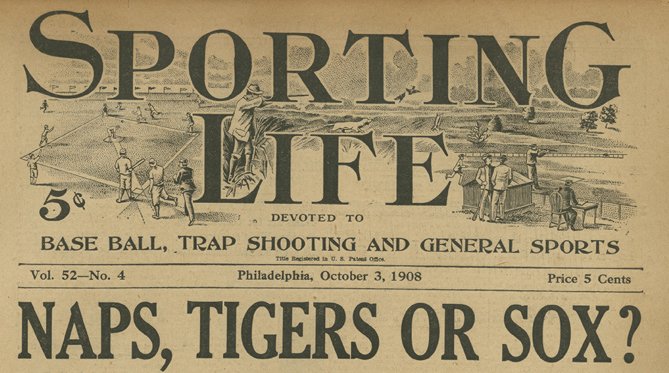Currently I am conducting a large edit to a category of True Champion’s Historical Franchise Performance Algorithm. This baseball performance category is one of the trickier types of historical success to quantify. The concept of what Pennant Races used to represent to fans and how they functioned needs to be fully understood in order to accurately quantify this type of on-field success and award performance points to MLB teams over their histories.
For nearly a century, Major League Baseball believed that the best and most legitimate way to crown their Champion was to have a long regular season, with a very large sample size. After which, the season concluded with the Division Champions qualifying for the League’s Championship Series; and prior to 1969, the League Champions went straight into the World Series.
In fact, this is a very legitimate format that ensures that the League’s best teams will rise to the top, and not fall victim to a short best-of-5 series, and especially, the randomness of the new 1-game wild card playoff.
A Quick Aside regarding the 1-Game Playoff
In recent years, baseball has gone away from its tradition and expanded the playoffs again. In my opinion, the new 1-game wild card playoff compromises the integrity of MLB’s results. Don’t get me wrong- I am in favor of having more teams make the playoffs, I just don’t think it’s justifiable to have a 162-game season reduced to a 1-game playoff for 4 very good teams.
More than any other point, (and certainly many good objections can be made), the number 1 reason I would cite claiming this format is not valid is that starting pitching rotations are at the heart of baseball as a sport. The 1-game playoff gives the advantage to the team with the best pitcher, instead of how baseball has always been structured- where the advantage is supposed to go to the team with the best 4-5 man rotation and deepest bullpen.
The size of any league’s playoff-format should be in proportion to the number of games in the regular season. The best analogy I’ve heard, that summarizes my feelings, is that the 1-game wild card playoff is like having 2 marathon runners break a tie in a sprint. (Although exciting, this is not a valid way of crowning the best marathon runner.)
Hating on the 1-game playoff is not the point of this article, but I will certainly re-visit this topic down the road.
Back to Pennant Races
Prior to the change that was made in 1994/1995, (where the number of teams that made the playoffs went from 4 to 8), baseball deployed a playoff format that I would term “Champions only”. It would be incorrect to refer to this format as ‘the playoffs’; rather MLB’s postseason was just the Championship Series(s). This format that was used by Major League Baseball for the majority of its history creates a tricky situation when it comes to quantifying the performance-history of baseball.
One of the most fundamental categories in my Historical Franchise Performance Algorithm I’ve termed “Notable Regular Season Achievements”. In this category, franchises receive positive performance points for qualifying for their league’s postseason.
This creates an issue because True Champion’s algorithm is built not only to compare franchises in the same league/sport but also between sports. This is problematic, because historically, baseball and football have had a much smaller percentage of their league qualify for the postseason than hockey and basketball.
MLB teams in the past would go for decades without “making the playoffs”. However, that didn’t mean that they did not have great seasons and play meaningful games which functioned like modern-day playoff games during those time periods. Important games in September for most teams meant the season had been a success.
In order to quantify Major League Baseball’s franchise-seasons accurately during most of its history, I needed to quantify what it meant for teams to be involved in these late-season Pennant Races.
Playing meaningful games in September, is the historical equivalent to a modern-day playoff qualification in the MLB.
With such a large schedule, many teams would be out of the hunt for the Pennant by July. When teams were playing relevant games in August, and then especially in September, this created the same excitement for fans as a modern-day playoff birth.
As baseball fans, we need to become more aware that these historical seasons should not be judged like present day seasons, in this sense:
Often times, it seems fans and the media, define modern success and failure by the following logic:
A) A team qualifies for the playoffs= successful season.
B) A team does not qualify for the postseason= failed season.
Optimal way of Quantifying Pennant Races- Key Data Currently Missing
In order to quantify this category of performance in the best possible way, there is important information that I have not been able to find yet. Looking at the final standings of any given season only reveals part of the story.
In order to quantify Pennant Races fully accurately the following information would be needed:
- How involved was the team in the Pennant Race?
- When specifically did they fall out of the race? (Both in essence, and then, mathematically.)
- What were the Division Standings on August 1st?
- What were the Division Standings on September 1st?
The most important data that is missing is being able to view the standings as of September 1st. (To a lesser extent, August 1st as well). It’s only with these 2 pieces of data, as well as the final standings which are easy to find, that one could accurately understand how involved a team was in the chase for the Pennant.
Here’s a hypothetical example to illustrate why the Final Standings are not enough to quantify this optimally. In both scenarios, a team finishes 3 games back of the Division winner:
Example 1- Red Sox finish 3 Games Back of the Division Winner (Yankees)
August 1st- 12 games back September 1st- 8 games back
The Yankees built a big enough lead that they were coasting by the end of the season and resting players in the final week; while the Red Sox got hot in September and closed the gap to 3 games by the end of the season. However, they never really challenged the Yankees grip on the Division.
Example 2- Tigers finish 3 Games Back of the Division Winner (Yankees)
August 1st- 1 game back September 1st- Lead Division by 2 games
The Tigers and the Yankees are neck-and-neck all season, and the lead for the Division changes many times. The Pennant is in limbo right up until the last few days of the season. The Tigers had a 2 game- lead over the Yankees with 10 games to play. However, the Tigers finish the season 3-7 in their last 10 games, and the Yankees finish 8-2. The Yankees make up 5 games on the Tigers in the last 10 games.
*In both examples, the Tigers and Red Sox both finish 3 games back of the Yankees, however, these results as they happened were completely different.
In the 1st example, the Red Sox get hot in meaningless late season games and make the race for the Pennant look a lot closer than it was. September was not filled with 'meaningful games'.
In the 2nd example, the Tigers are leading the Division on September 1st and also with 10 games to play. There is a dramatic shift during the last week of the season, and the Tigers endure a late-season melt down. However, on the bright side, September was filled with exciting and meaningful games.
How True Champion Quantifies Pennant Races
For now, until I have access to the information which can solve the above conundrum, I have made the determination that teams that finish within 8.5 games back of the Division winners will receive positive performance points for being involved in a Pennant Race. Although, I don’t have all the information I wish I had, we can say with certainty that if a team finishes less than 9 games back of the Division Champion, they were alive in the chase at the All-Star break, and likely on September 1st as well.
The closer they are to the Division Champion will determines how many points they receive in the category- Notable Regular Season Achievements; sub-category- Pennant Race Points.
This category of performance-points is only awarded through 1993. Major League Baseball goes to a much more modern playoff format in 1995, which takes away the necessity to award these points. Prior to 1995, the only way to qualify for the postseason was to win your 6, 7, 8 or 10 team Division/ League.
From 1977-1992, only 15.4% of MLB teams qualified for the postseason every year. The percentage of qualifiers nearly doubles to 28.6% in 1995; with a 3rd Division winner per league, as well as a Wild Card team.
Coming soon: Upon conclusion of this major edit to improve the accuracy of points awarded for Pennant Races for the Major League Baseball franchises from 1969-1993, my next project will be to quantify MLB franchise-seasons from 1950- 1968.

